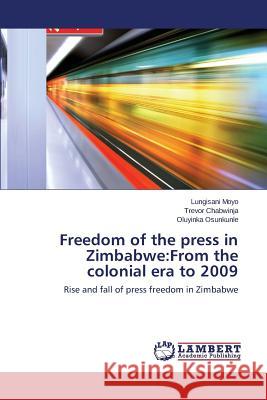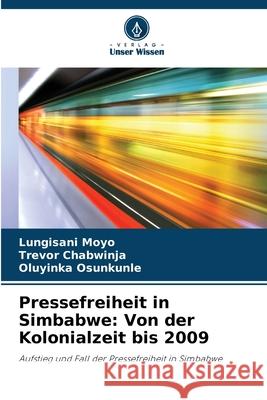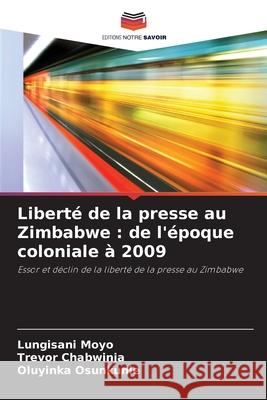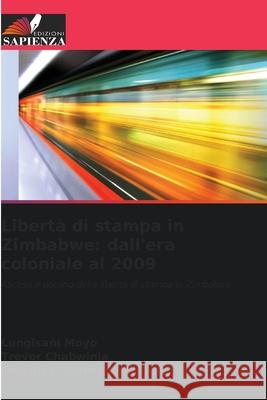topmenu
Wyniki wyszukiwania:
wyszukanych pozycji: 6
 |
Freedom of the press in Zimbabwe: From the colonial era to 2009
ISBN: 9783847334767 / Angielski / Miękka / 2015 / 92 str. Termin realizacji zamówienia: ok. 10-14 dni roboczych. The focus of this book was on the nature and operation of laws and regulations that were and are still being used to limit the freedom of the media in Zimbabwe. The focal point of this book was to examine the impact of media laws in Zimbabwe on the freedom of expression of its citizens. The author scrutinised media laws such as Access to Information and Protection of Privacy Act (AIPPA), the Public Order and Security Act (POSA) and the Broadcasting Services Act (BSA). I focused mainly on the period before the amendment of the constitution ascended in 2013.The underpinning theoretical...
The focus of this book was on the nature and operation of laws and regulations that were and are still being used to limit the freedom of the media in...
|
cena:
245,00 |
 |
Pressefreiheit in Simbabwe: Von der Kolonialzeit bis 2009
ISBN: 9786209108389 / Niemiecki / Miękka / 2025 / 88 str. Termin realizacji zamówienia: ok. 10-14 dni roboczych. Der Schwerpunkt dieses Buches lag auf der Art und Funktionsweise von Gesetzen und Vorschriften, die zur Einschränkung der Medienfreiheit in Simbabwe eingesetzt wurden und werden. Im Mittelpunkt dieses Buches stand die Untersuchung der Auswirkungen der Mediengesetze in Simbabwe auf die Meinungsfreiheit der Bürger. Der Autor untersuchte Mediengesetze wie das Gesetz über den Zugang zu Informationen und den Schutz der Privatsphäre (AIPPA), das Gesetz über öffentliche Ordnung und Sicherheit (POSA) und das Gesetz über Rundfunkdienste (BSA). Ich konzentrierte mich hauptsächlich auf den...
Der Schwerpunkt dieses Buches lag auf der Art und Funktionsweise von Gesetzen und Vorschriften, die zur Einschränkung der Medienfreiheit in Simbabwe ...
|
cena:
245,00 |
 |
Liberté de la presse au Zimbabwe : de l'époque coloniale à 2009
ISBN: 9786209090462 / Francuski / Miękka / 2025 / 84 str. Termin realizacji zamówienia: ok. 10-14 dni roboczych. Cet ouvrage s'intéresse principalement à la nature et au fonctionnement des lois et réglementations qui ont été et sont encore utilisées pour limiter la liberté des médias au Zimbabwe. Il examine en particulier l'impact des lois sur les médias au Zimbabwe sur la liberté d'expression des citoyens. L'auteur a examiné de près les lois sur les médias telles que la loi sur l'accès à l'information et la protection de la vie privée (AIPPA), la loi sur l'ordre public et la sécurité (POSA) et la loi sur les services de radiodiffusion (BSA). Je me suis principalement concentré sur la...
Cet ouvrage s'intéresse principalement à la nature et au fonctionnement des lois et réglementations qui ont été et sont encore utilisées pour li...
|
cena:
245,00 |
 |
Liberdade de imprensa no Zimbábue: da era colonial até 2009
ISBN: 9786209103261 / Portugalski / Miękka / 2025 / 84 str. Termin realizacji zamówienia: ok. 10-14 dni roboczych. |
cena:
245,00 |
 |
Wolnosc prasy w Zimbabwe: od czasów kolonialnych do 2009 r.
ISBN: 9786209098147 / Polski / Miękka / 2025 / 80 str. Termin realizacji zamówienia: ok. 10-14 dni roboczych. |
cena:
245,00 |
 |
Libertà di stampa in Zimbabwe: dall'era coloniale al 2009
ISBN: 9786209095580 / Włoski / Miękka / 2025 / 84 str. Termin realizacji zamówienia: ok. 10-14 dni roboczych. |
cena:
245,00 |










